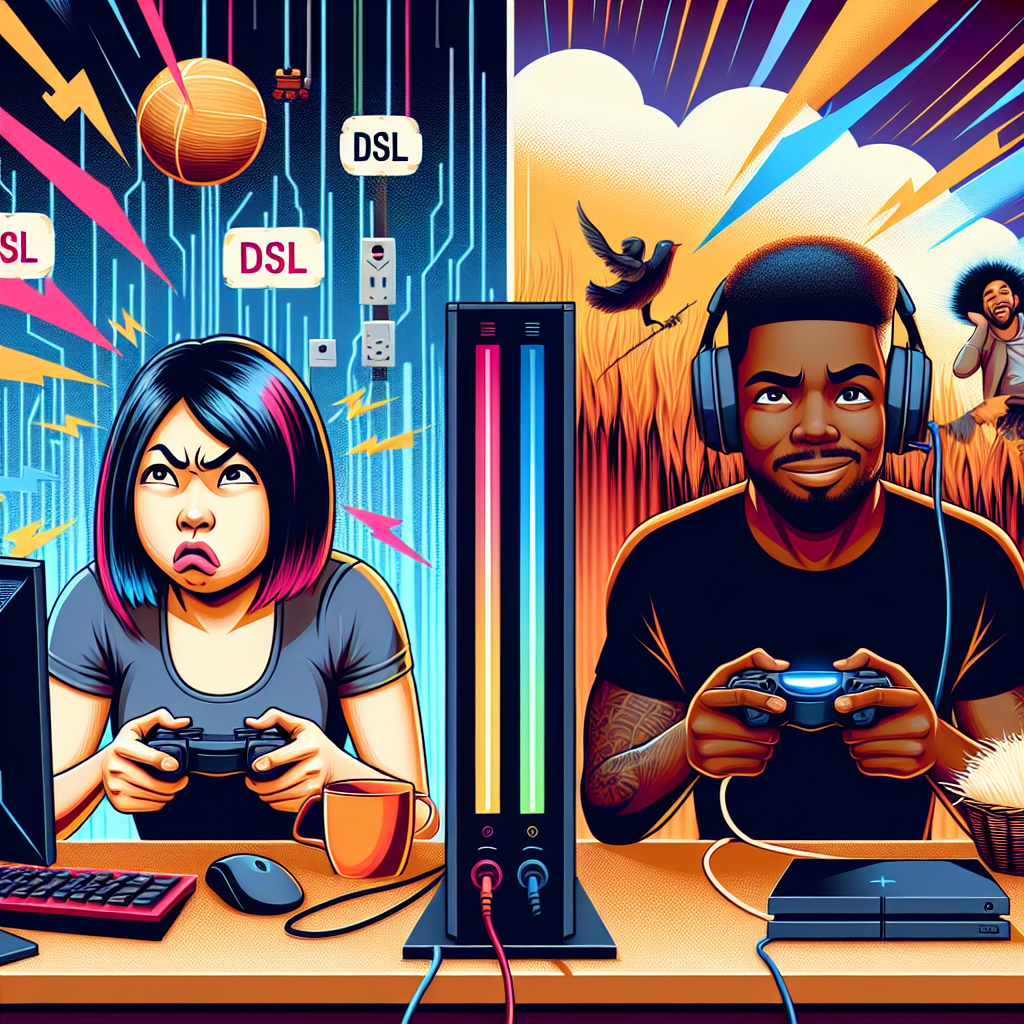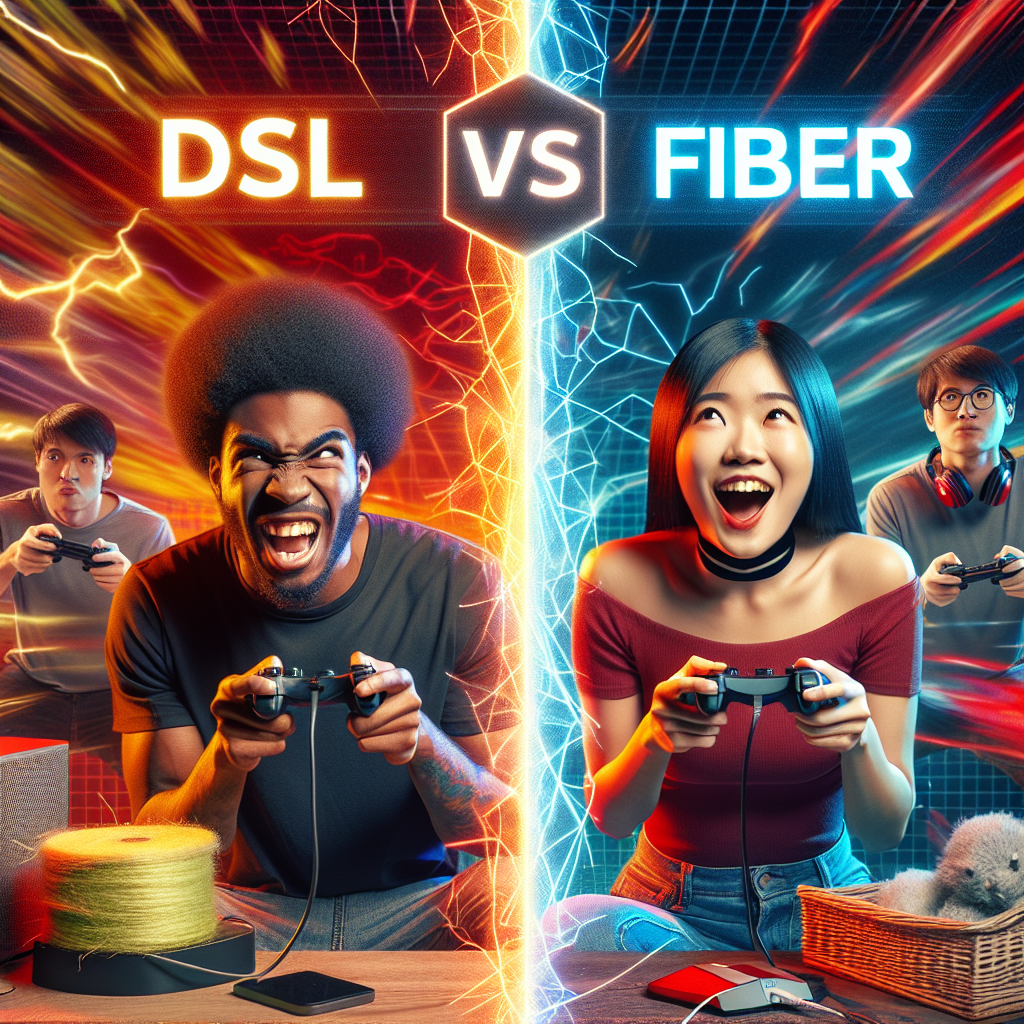In today’s fast-paced world of online gaming, having a reliable internet connection is crucial for gamers. DSL (Digital Subscriber Line) and Fiber Optic internet are two popular options for connecting to the virtual gaming world, but which is better for gamers? DSL uses telephone lines to transmit data, while Fiber Optic internet delivers data at lightning-fast speeds through thin glass fibers. The debate over DSL vs Fiber for gaming continues to rage on, with gamers debating the pros and cons of each. Join us as we delve into the world of internet connections and explore which option reigns supreme for the ultimate gaming experience.
Fiber is generally considered the best Internet connection for gamers because it offers faster and more reliable speeds compared to DSL. Fiber can provide lower latency and more stable connections, which are important factors for online gaming. Additionally, fiber connections tend to have higher upload speeds, which is beneficial for streaming or uploading gameplay videos. Overall, if you’re looking for the best internet connection for gaming, fiber is the way to go.
Understanding the Basics of DSL and Fiber Internet Connections
Definition of DSL and Fiber optics
DSL, which stands for Digital Subscriber Line, is a type of internet connection that uses existing copper telephone lines to transmit data. It operates on a frequency band that allows for internet access while still being able to use the phone line for voice calls simultaneously. On the other hand, Fiber optics use thin strands of glass or plastic to transmit data as pulses of light. This technology allows for much faster and more reliable internet connections compared to traditional DSL.
Speed and bandwidth capabilities of DSL vs Fiber
DSL connections typically offer speeds ranging from 1-100 Mbps, depending on the provider and location. However, the actual speed experienced by users can vary greatly due to factors such as distance from the provider’s central office and network congestion. In contrast, Fiber optic connections can deliver speeds of up to 1 Gbps (1000 Mbps) and beyond. This high-speed capability of Fiber makes it ideal for online gaming, where low latency and fast download/upload speeds are crucial for a smooth gaming experience.
Availability and cost differences
DSL internet is widely available in many areas, especially in rural or remote locations where Fiber infrastructure may not have been established. However, the downside is that DSL speeds and reliability can be inconsistent, particularly over longer distances. Fiber optic networks, on the other hand, are more commonly found in urban areas and are expanding rapidly. While the initial installation cost of Fiber may be higher than DSL, the long-term benefits of faster speeds and more reliable connections often justify the higher price for serious gamers looking for the best online gaming experience.
Performance Comparison for Gaming

Latency and Ping Rates
- Impact of latency on gaming experience
- Latency, also known as ping, refers to the time it takes for data packets to travel from the gamer’s device to the game server and back.
- High latency can result in delays between the player’s actions and the game’s response, leading to a poor gaming experience.
- Gamers often experience lag, stuttering, and even disconnections in online multiplayer games when latency is high.
-
Competitive gamers, especially in fast-paced games, are highly sensitive to latency issues as split-second reactions can determine victory or defeat.
-
How DSL and Fiber differ in latency
- DSL (Digital Subscriber Line) connections typically have higher latency compared to Fiber optic connections.
- DSL transmits data over copper telephone lines, which can introduce signal interference and longer transmission times, leading to higher latency.
- Fiber optic connections use light signals transmitted through glass fibers, resulting in significantly lower latency due to faster data transmission speeds.
- Fiber’s low latency makes it ideal for real-time online gaming, providing gamers with a more responsive and seamless gameplay experience.
- Gamers opting for Fiber internet are likely to experience reduced latency issues, resulting in smoother gameplay and better overall performance.
Bandwidth and Download Speeds
Performance Comparison for Gaming
- Importance of high bandwidth for gaming
In the realm of online gaming, bandwidth plays a crucial role in determining the overall gaming experience. Bandwidth refers to the maximum rate at which data can be transferred over a network connection, and for gamers, a higher bandwidth equates to smoother gameplay, reduced lag, and faster response times.
- Download speed comparison between DSL and Fiber
When comparing DSL and Fiber optic internet connections in terms of download speeds, Fiber outshines DSL significantly. Fiber internet, known for its high-speed capabilities, offers symmetrical download and upload speeds, making it ideal for online gaming where low latency and quick data transfer are paramount. On the other hand, DSL connections, which utilize traditional copper phone lines, often struggle to deliver consistent download speeds, especially during peak usage times. This discrepancy in download speeds can directly impact a gamer’s ability to download game updates, patches, and new content swiftly, leading to potential delays and frustrations during gameplay.
Reliability and Stability in Online Gaming
- Factors affecting reliability in DSL and Fiber connections
When it comes to online gaming, the reliability of the internet connection is crucial. DSL connections rely on traditional copper telephone lines, which can be susceptible to interference and distance limitations. This can lead to fluctuations in connection speeds and potential latency issues during gameplay. On the other hand, Fiber-optic connections use fiber-optic cables that transmit data using light signals, offering faster and more stable internet speeds. Fiber connections are less prone to interference, providing a more reliable gaming experience with consistent speeds.
- Differences in stability during peak gaming hours
During peak gaming hours, when many users are simultaneously online and using bandwidth-intensive applications, the stability of the internet connection becomes even more critical. DSL connections may struggle to maintain consistent speeds and low latency during these busy periods due to the shared nature of the infrastructure. Fiber connections, with their dedicated lines and higher bandwidth capacity, are better equipped to handle the increased demand during peak hours. Gamers using Fiber-optic internet are less likely to experience slowdowns or lag spikes, ensuring a more stable gaming experience.
- Impact of connection stability on online gaming experience
The stability of the internet connection directly impacts the overall online gaming experience. A reliable and stable connection is essential for fast response times, smooth gameplay, and minimal lag. DSL connections, with their potential for fluctuations in speed and latency issues, can lead to frustrating gaming sessions with delays in player actions and poor performance in competitive online games. In contrast, Fiber-optic connections offer consistent speeds and low latency, providing gamers with a competitive edge and a more enjoyable gaming experience overall.

Future-Proofing Your Gaming Setup
In the ever-evolving world of gaming, it is crucial to consider the future scalability of your internet connection. When comparing DSL and Fiber optics, the issue of future-proofing becomes paramount.
Scalability of DSL vs Fiber for future gaming needs
-
DSL: DSL internet connections have limited bandwidth capabilities, which can hinder performance when newer, more data-intensive games are released. The bandwidth limitations of DSL may result in slower download speeds and higher latency, impacting your gaming experience.
-
Fiber: Fiber optic internet, on the other hand, offers significantly higher bandwidth capacity, making it more suitable for handling the demands of future gaming technologies. With Fiber, gamers can enjoy faster download speeds, lower latency, and smoother gameplay even as games become more data-heavy.
Technological advancements and compatibility with gaming consoles
-
DSL: While DSL may be sufficient for current gaming needs, its compatibility with future gaming consoles and technologies may be limited. As gaming consoles continue to advance in terms of graphics and online capabilities, DSL connections may struggle to keep up, leading to potential compatibility issues.
-
Fiber: Fiber optic internet is at the forefront of technological advancements and is more likely to be compatible with upcoming gaming consoles and innovations. Its high-speed, low-latency nature ensures seamless integration with new gaming technologies, providing gamers with a more immersive and responsive gaming experience.
Long-term cost considerations for upgrading internet connection
- DSL: While DSL internet may be more affordable in the short term, the long-term cost considerations for upgrading to meet future gaming needs should not be overlooked. Upgrading an existing DSL connection to accommodate higher bandwidth requirements can incur additional costs and may not provide the same level of performance as Fiber optic internet.

– Fiber: Although Fiber optic internet may have higher initial installation costs, its long-term benefits outweigh the expenses. Fiber offers superior performance, reliability, and scalability, making it a cost-effective choice for gamers looking to future-proof their gaming setup and ensure optimal connectivity for years to come.
Common Misconceptions About DSL and Fiber for Gaming
Addressing myths about DSL and Fiber performance in gaming
Many gamers often believe that DSL connections are sufficient for gaming needs, while fiber optics are only marginally better. However, this misconception fails to consider the significant differences in speed and reliability between the two types of connections. DSL connections, which rely on traditional copper telephone lines, often struggle to provide the consistent speeds and low latency required for seamless gaming experiences. On the other hand, fiber-optic connections use light signals transmitted through thin glass fibers, offering much higher speeds and lower latency compared to DSL.
Clarifying misconceptions about latency and speed
One common misconception is that latency only impacts online multiplayer games, leading some to believe that it is not a crucial factor for single-player gaming. However, latency, also known as ping, can affect all types of gaming experiences by causing delays in responsiveness and affecting the overall smoothness of gameplay. Fiber-optic connections typically have significantly lower latency compared to DSL, making them the preferred choice for gamers who prioritize real-time responsiveness and competitive edge. Additionally, the speed capabilities of fiber optics far exceed those of DSL, allowing for faster downloads, uploads, and smoother streaming experiences.
Importance of choosing the right internet connection for optimal gaming experience
Choosing the right internet connection is crucial for gamers looking to maximize their gaming experience. While DSL may be suitable for casual gamers or those with budget constraints, serious gamers and esports enthusiasts are likely to benefit significantly from upgrading to a fiber-optic connection. The superior speed, lower latency, and overall reliability of fiber optics can make a noticeable difference in gameplay, especially in fast-paced and competitive online gaming scenarios. By dispelling the misconceptions surrounding DSL and fiber optics, gamers can make informed decisions to enhance their gaming performance and enjoyment.
Making the Right Choice for Your Gaming Needs
When it comes to choosing the best internet connection for gaming, there are several key considerations to keep in mind to ensure an optimal gaming experience. Whether you opt for DSL or Fiber, understanding your specific gaming needs and preferences is crucial in making the right choice.
- Considerations for choosing between DSL and Fiber:
- Speed and Reliability: DSL connections typically offer slower speeds compared to Fiber, which can result in lags and latency issues during gameplay. Fiber, on the other hand, provides high-speed internet with low latency, ideal for online gaming where split-second reactions are crucial.
- Bandwidth: Fiber connections generally offer higher bandwidth capacity, allowing for smoother gameplay, faster downloads, and seamless streaming. DSL connections may struggle to support multiple devices simultaneously, impacting gaming performance.
-
Ping Rates: Fiber internet typically boasts lower ping rates, reducing delays in data transmission between the gaming server and your device. Lower ping rates contribute to a more responsive gaming experience, especially in competitive online gaming scenarios.
-
Personal preferences and budget constraints:
- Gaming Habits: Consider how often you game, the types of games you play, and whether you engage in multiplayer online gaming. Heavy gamers or those who play competitive titles may benefit more from a Fiber connection due to its superior speed and reliability.
- Budget: While Fiber internet is known for its high performance, it often comes at a higher price point compared to DSL. Evaluate your budget constraints and weigh the cost-benefit ratio of investing in Fiber for your gaming needs.
-
Future-Proofing: When deciding between DSL and Fiber, consider your future gaming requirements. Fiber is considered a more future-proof option as it can accommodate evolving technologies and higher bandwidth demands that may arise with future gaming advancements.
-
Seeking professional advice for tailored recommendations:
- Consulting ISPs: Reach out to internet service providers to inquire about their DSL and Fiber packages tailored for gaming. ISPs can provide insights into the specific features, speeds, and reliability of each connection type to help you make an informed decision.
- Tech Experts: Seeking advice from tech experts or gaming communities can offer valuable perspectives on the best internet connection for gaming. Engaging with knowledgeable individuals in the gaming industry can help you navigate the technical aspects and nuances of DSL and Fiber connections.
FAQs for DSL vs Fiber for Gaming: Which Internet Connection is Best for Gamers?
What is the main difference between DSL and Fiber internet connections for gaming?
DSL (Digital Subscriber Line) internet connections use existing copper telephone lines to transmit data, while Fiber optic connections use ultra-fast fiber optic cables. The main difference lies in the speed and reliability of the connection, with Fiber typically offering faster speeds and more stable connections compared to DSL.
Does the type of internet connection affect online gaming performance?
Yes, the type of internet connection can significantly affect online gaming performance. Fiber optic connections tend to offer lower latency and faster upload and download speeds, resulting in smoother gameplay and reduced lag compared to DSL connections. This can be crucial for competitive gaming where split-second reactions can make all the difference.
Can I play online games on DSL internet or is Fiber necessary?
While it is possible to play online games on DSL internet, Fiber optic connections are generally recommended for a better gaming experience. With Fiber, you can enjoy faster speeds, lower latency, and more reliable connectivity, which can make a noticeable difference in your gameplay, especially in fast-paced and competitive online games.
Are there any other factors to consider when choosing between DSL and Fiber for gaming?
In addition to speed and reliability, factors such as cost, availability, and your location can also play a role in selecting the best internet connection for gaming. While Fiber is generally considered the superior option for gaming, it may not be available in all areas or may come at a higher cost compared to DSL. It’s important to weigh these factors and consider your specific gaming needs before making a decision.